Yanghui Rao
HopWeaver: Synthesizing Authentic Multi-Hop Questions Across Text Corpora
May 21, 2025Abstract:Multi-Hop Question Answering (MHQA) is crucial for evaluating the model's capability to integrate information from diverse sources. However, creating extensive and high-quality MHQA datasets is challenging: (i) manual annotation is expensive, and (ii) current synthesis methods often produce simplistic questions or require extensive manual guidance. This paper introduces HopWeaver, the first automatic framework synthesizing authentic multi-hop questions from unstructured text corpora without human intervention. HopWeaver synthesizes two types of multi-hop questions (bridge and comparison) using an innovative approach that identifies complementary documents across corpora. Its coherent pipeline constructs authentic reasoning paths that integrate information across multiple documents, ensuring synthesized questions necessitate authentic multi-hop reasoning. We further present a comprehensive system for evaluating synthesized multi-hop questions. Empirical evaluations demonstrate that the synthesized questions achieve comparable or superior quality to human-annotated datasets at a lower cost. Our approach is valuable for developing MHQA datasets in specialized domains with scarce annotated resources. The code for HopWeaver is publicly available.
iTFKAN: Interpretable Time Series Forecasting with Kolmogorov-Arnold Network
Apr 23, 2025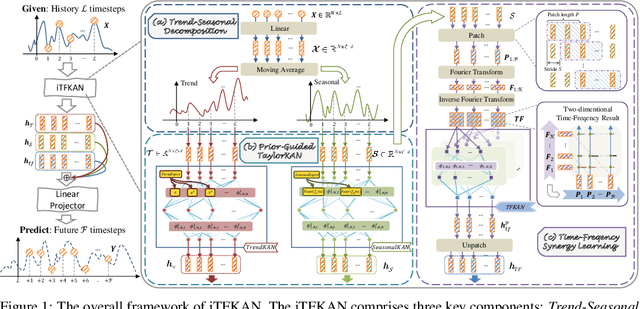



Abstract:As time evolves, data within specific domains exhibit predictability that motivates time series forecasting to predict future trends from historical data. However, current deep forecasting methods can achieve promising performance but generally lack interpretability, hindering trustworthiness and practical deployment in safety-critical applications such as auto-driving and healthcare. In this paper, we propose a novel interpretable model, iTFKAN, for credible time series forecasting. iTFKAN enables further exploration of model decision rationales and underlying data patterns due to its interpretability achieved through model symbolization. Besides, iTFKAN develops two strategies, prior knowledge injection, and time-frequency synergy learning, to effectively guide model learning under complex intertwined time series data. Extensive experimental results demonstrated that iTFKAN can achieve promising forecasting performance while simultaneously possessing high interpretive capabilities.
Detecting Emotional Incongruity of Sarcasm by Commonsense Reasoning
Dec 17, 2024Abstract:This paper focuses on sarcasm detection, which aims to identify whether given statements convey criticism, mockery, or other negative sentiment opposite to the literal meaning. To detect sarcasm, humans often require a comprehensive understanding of the semantics in the statement and even resort to external commonsense to infer the fine-grained incongruity. However, existing methods lack commonsense inferential ability when they face complex real-world scenarios, leading to unsatisfactory performance. To address this problem, we propose a novel framework for sarcasm detection, which conducts incongruity reasoning based on commonsense augmentation, called EICR. Concretely, we first employ retrieval-augmented large language models to supplement the missing but indispensable commonsense background knowledge. To capture complex contextual associations, we construct a dependency graph and obtain the optimized topology via graph refinement. We further introduce an adaptive reasoning skeleton that integrates prior rules to extract sentiment-inconsistent subgraphs explicitly. To eliminate the possible spurious relations between words and labels, we employ adversarial contrastive learning to enhance the robustness of the detector. Experiments conducted on five datasets demonstrate the effectiveness of EICR.
MIND: Effective Incorrect Assignment Detection through a Multi-Modal Structure-Enhanced Language Model
Dec 05, 2024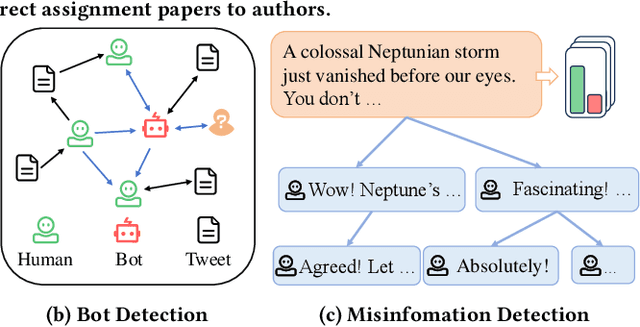
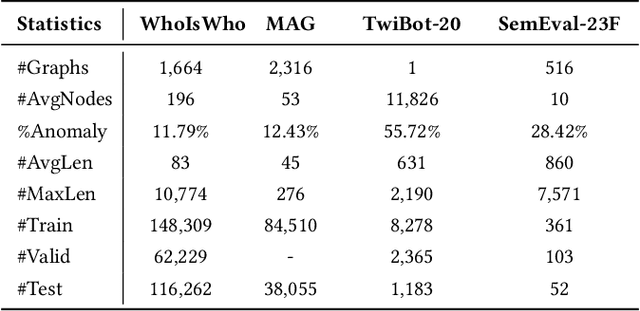
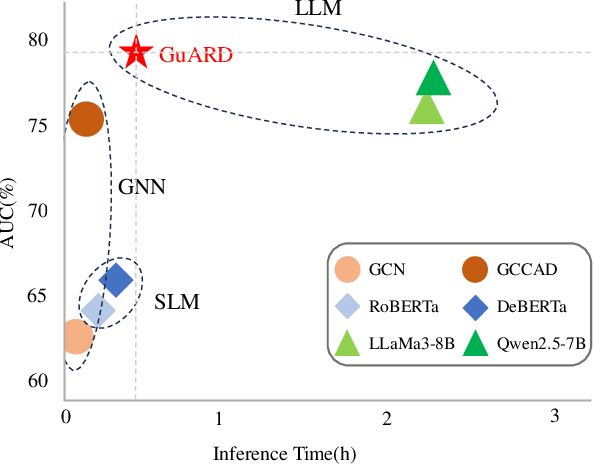

Abstract:The rapid growth of academic publications has exacerbated the issue of author name ambiguity in online digital libraries. Despite advances in name disambiguation algorithms, cumulative errors continue to undermine the reliability of academic systems. It is estimated that over 10% paper-author assignments are rectified when constructing the million-scale WhoIsWho benchmark. Existing endeavors to detect incorrect assignments are either semantic-based or graph-based approaches, which fall short of making full use of the rich text attributes of papers and implicit structural features defined via the co-occurrence of paper attributes. To this end, this paper introduces a structure-enhanced language model that combines key structural features from graph-based methods with fine-grained semantic features from rich paper attributes to detect incorrect assignments. The proposed model is trained with a highly effective multi-modal multi-turn instruction tuning framework, which incorporates task-guided instruction tuning, text-attribute modality, and structural modality. Experimental results demonstrate that our model outperforms previous approaches, achieving top performance on the leaderboard of KDD Cup 2024. Our code has been publicly available.
IterSelectTune: An Iterative Training Framework for Efficient Instruction-Tuning Data Selection
Oct 17, 2024



Abstract:As large language models (LLMs) continue to advance, instruction tuning has become critical for improving their ability to generate accurate and contextually appropriate responses. Although numerous instruction-tuning datasets have been developed to enhance LLM performance, selecting high-quality instruction data from large source datasets typically demands significant human effort. In this work, we introduce $\textbf{IterSelectTune}$, an efficient, cost-effective iterative training policy for selecting high-quality instruction data with no human involvement and limited reliance on GPT-4. By fine-tuning on approximately 20\% of the source data, our method consistently outperforms models fine-tuned on the full dataset across multiple benchmarks and public test datasets. These results highlight the effectiveness of our approach in enhancing LLM performance while reducing the computational resources required for instruction tuning.
Multimodal Clickbait Detection by De-confounding Biases Using Causal Representation Inference
Oct 10, 2024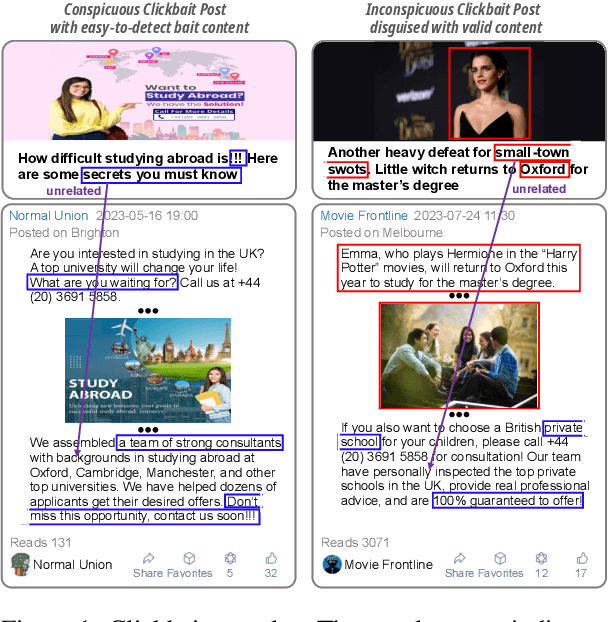

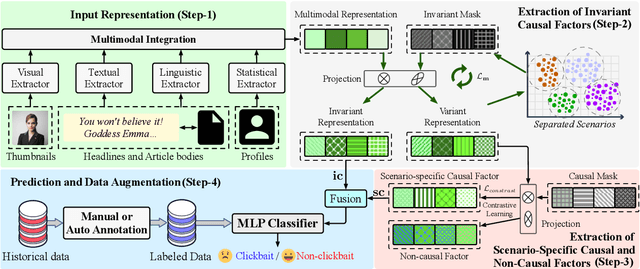

Abstract:This paper focuses on detecting clickbait posts on the Web. These posts often use eye-catching disinformation in mixed modalities to mislead users to click for profit. That affects the user experience and thus would be blocked by content provider. To escape detection, malicious creators use tricks to add some irrelevant non-bait content into bait posts, dressing them up as legal to fool the detector. This content often has biased relations with non-bait labels, yet traditional detectors tend to make predictions based on simple co-occurrence rather than grasping inherent factors that lead to malicious behavior. This spurious bias would easily cause misjudgments. To address this problem, we propose a new debiased method based on causal inference. We first employ a set of features in multiple modalities to characterize the posts. Considering these features are often mixed up with unknown biases, we then disentangle three kinds of latent factors from them, including the invariant factor that indicates intrinsic bait intention; the causal factor which reflects deceptive patterns in a certain scenario, and non-causal noise. By eliminating the noise that causes bias, we can use invariant and causal factors to build a robust model with good generalization ability. Experiments on three popular datasets show the effectiveness of our approach.
Self-supervised Topic Taxonomy Discovery in the Box Embedding Space
Aug 27, 2024Abstract:Topic taxonomy discovery aims at uncovering topics of different abstraction levels and constructing hierarchical relations between them. Unfortunately, most of prior work can hardly model semantic scopes of words and topics by holding the Euclidean embedding space assumption. What's worse, they infer asymmetric hierarchical relations by symmetric distances between topic embeddings. As a result, existing methods suffer from problems of low-quality topics at high abstraction levels and inaccurate hierarchical relations. To alleviate these problems, this paper develops a Box embedding-based Topic Model (BoxTM) that maps words and topics into the box embedding space, where the asymmetric metric is defined to properly infer hierarchical relations among topics. Additionally, our BoxTM explicitly infers upper-level topics based on correlation between specific topics through recursive clustering on topic boxes. Finally, extensive experiments validate high-quality of the topic taxonomy learned by BoxTM.
Topic Driven Adaptive Network for Cross-Domain Sentiment Classification
Nov 28, 2021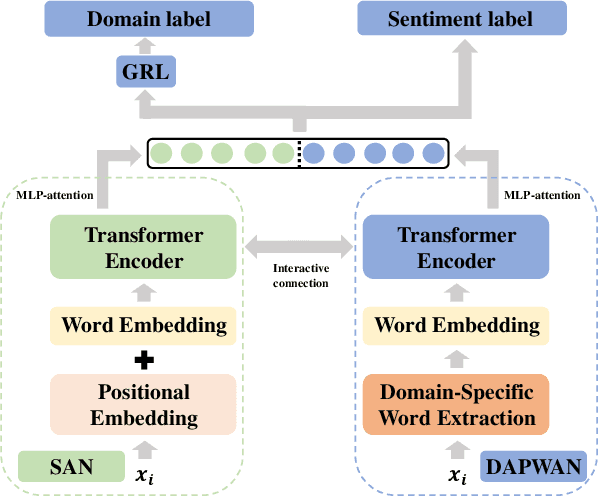
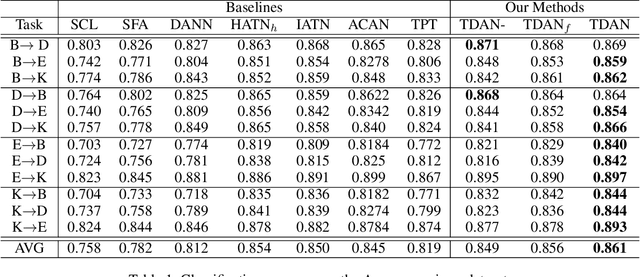


Abstract:Cross-domain sentiment classification has been a hot spot these years, which aims to learn a reliable classifier using labeled data from the source domain and evaluate it on the target domain. In this vein, most approaches utilized domain adaptation that maps data from different domains into a common feature space. To further improve the model performance, several methods targeted to mine domain-specific information were proposed. However, most of them only utilized a limited part of domain-specific information. In this study, we first develop a method of extracting domain-specific words based on the topic information. Then, we propose a Topic Driven Adaptive Network (TDAN) for cross-domain sentiment classification. The network consists of two sub-networks: semantics attention network and domain-specific word attention network, the structures of which are based on transformers. These sub-networks take different forms of input and their outputs are fused as the feature vector. Experiments validate the effectiveness of our TDAN on sentiment classification across domains.
Context Reinforced Neural Topic Modeling over Short Texts
Aug 11, 2020

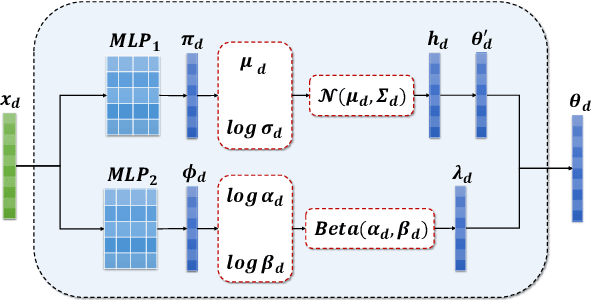
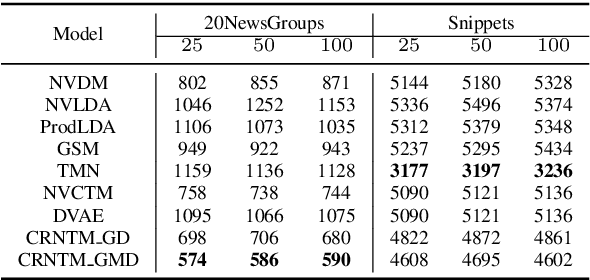
Abstract:As one of the prevalent topic mining tools, neural topic modeling has attracted a lot of interests for the advantages of high efficiency in training and strong generalisation abilities. However, due to the lack of context in each short text, the existing neural topic models may suffer from feature sparsity on such documents. To alleviate this issue, we propose a Context Reinforced Neural Topic Model (CRNTM), whose characteristics can be summarized as follows. Firstly, by assuming that each short text covers only a few salient topics, CRNTM infers the topic for each word in a narrow range. Secondly, our model exploits pre-trained word embeddings by treating topics as multivariate Gaussian distributions or Gaussian mixture distributions in the embedding space. Extensive experiments on two benchmark datasets validate the effectiveness of the proposed model on both topic discovery and text classification.
Attentional Encoder Network for Targeted Sentiment Classification
Apr 01, 2019

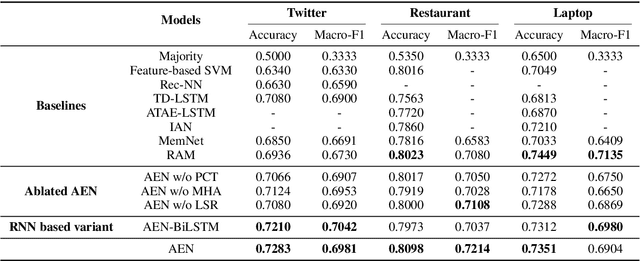
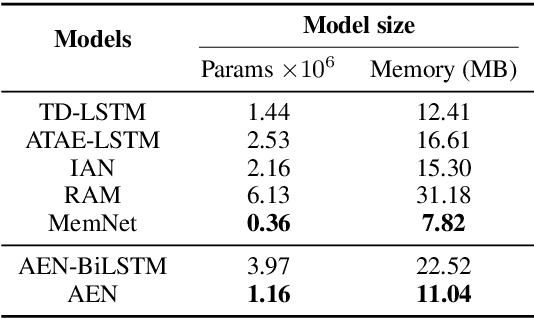
Abstract:Targeted sentiment classification aims at determining the sentimental tendency towards specific targets. Most of the previous approaches model context and target words with RNN and attention. However, RNNs are difficult to parallelize and truncated backpropagation through time brings difficulty in remembering long-term patterns. To address this issue, this paper proposes an Attentional Encoder Network (AEN) which eschews recurrence and employs attention based encoders for the modeling between context and target. We raise the label unreliability issue and introduce label smoothing regularization. We also apply pre-trained BERT to this task and obtain new state-of-the-art results. Experiments and analysis demonstrate the effectiveness and lightweight of our model.
 Add to Chrome
Add to Chrome Add to Firefox
Add to Firefox Add to Edge
Add to Edge